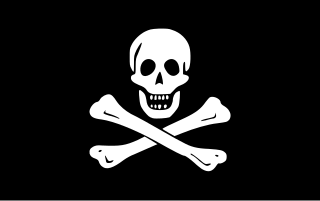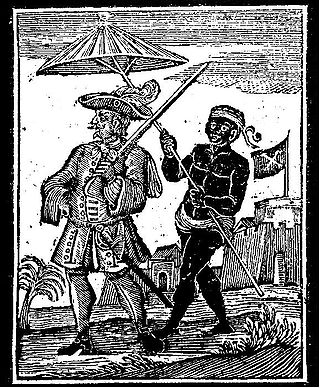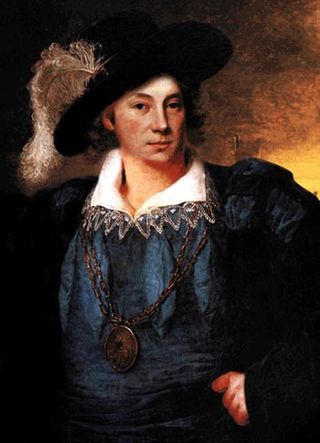Related Research Articles

William Kidd also known as Captain William Kidd or simply Captain Kidd, was a Scottish privateer. Conflicting accounts exist regarding his early life, but he was likely born in Dundee and later settled in New York City. By 1690, Kidd had become a highly successful privateer, commissioned to protect English interests in North America and the West Indies.

Piracy is an act of robbery or criminal violence by ship or boat-borne attackers upon another ship or a coastal area, typically with the goal of stealing cargo and other valuable goods. Those who conduct acts of piracy are called pirates, and vessels used for piracy are called pirate ships. The earliest documented instances of piracy were in the 14th century BC, when the Sea Peoples, a group of ocean raiders, attacked the ships of the Aegean and Mediterranean civilisations. Narrow channels which funnel shipping into predictable routes have long created opportunities for piracy, as well as for privateering and commerce raiding.

Buccaneers were a kind of privateer or free sailors particular to the Caribbean Sea during the 17th and 18th centuries. First established on northern Hispaniola as early as 1625, their heyday was from the Restoration in 1660 until about 1688, during a time when governments in the Caribbean area were not strong enough to suppress them.
Robert Culliford was a pirate from Cornwall who is best remembered for repeatedly checking the designs of Captain William Kidd.

Henry Every, also known as Henry Avery, sometimes erroneously given as Jack Avery or John Avery, was an English pirate who operated in the Atlantic and Indian oceans in the mid-1690s. He probably used several aliases throughout his career, including Benjamin Bridgeman, and was known as Long Ben to his crewmen and associates.
Adolph Esmit was a Danish colonial administrator and slave trader who served as governor of St. Thomas in the Danish West Indies from 1683 to 1684, and again from 1687 to 1688. He was born in Holstein. His older brother Nicolai Esmit preceded him as governor of St. Thomas.

A pirate code, pirate articles, or articles of agreement were a code of conduct for governing pirates. A group of sailors, on turning pirate, would draw up their own code or articles, which provided rules for discipline, division of stolen goods, and compensation for injured pirates. Breaking the code could get a pirate marooned or killed. These articles were designed to keep order, avoid dissension, and ensure the crews’ loyalty, which was crucial to survival.

Laurens Cornelis Boudewijn de Graaf was a Dutch pirate, mercenary, and naval officer in the service of the French colony of Saint-Domingue during the late 17th and early 18th century.

Joseph Bradish (1672–1700) was a pirate best known for a single incident involving a mutiny.
Captain John Coxon, sometimes referred to as John Coxen, was a late-seventeenth-century buccaneer who terrorized the Spanish Main. Coxon was one of the most famous of the Brethren of the Coast, a loose consortium of pirates and privateers. Coxon lived during the Buccaneering Age of Piracy.
Sir Thomas Lynch was the English governor of Jamaica on three separate occasions in the 17th century. He was also chief justice of Jamaica for a time.

The Atlantic World refers to the period between European colonisation of the Americas (1492-) and the early nineteenth century. Piracy became prevalent in this era because of the difficulty of policing this vast area, the limited state control over many parts of the coast and the competition between different European powers. The best known pirates of this era are the Golden Age pirates (c.1650-1730) who roamed the seas off the coast of North America, Africa and the Caribbean.
Richard Glover was a pirate and slave-trader active in the Caribbean and the Red Sea in the late 1690s.
George Cusack was an Irish pirate active in northern Europe and the West Indies in the late 17th century.
Josiah Raynor (1665–1743) was a pirate active in the Red Sea. As a pirate he captained the Batchelor’s Delight, which had been on a lengthy South Seas buccaneering voyage before Raynor's tenure.
John Swann was a minor pirate in the Indian Ocean, known almost entirely for speculation about his relationship with Robert Culliford.
Jean Hamlin was a French pirate active in the Caribbean and off the coast of Africa. He was often associated with St. Thomas's pirate-friendly Governor Adolph Esmit.
William Coward was a minor pirate active off the coast of Massachusetts. He is known for a single incident involving the seizure of one small vessel, largely thanks to events surrounding his trial.

Edmund Cooke was a merchant captain, buccaneer, and pirate. He is best known for sailing against the Spanish alongside Bartholomew Sharp, John Coxon, Basil Ringrose, Lionel Wafer, and other famous buccaneers. Cooke's flag was red-and-yellow striped and featured a hand holding a sword.
Matelotage was an agreement amongst pairs of European sailors, in particular buccaneers, in the 17th and early 18th century. As part of this economic partnership, "matelots" would agree to share their incomes, and inherit their partner's property in the case of their death. In addition, they would pledge to protect and fight alongside each other in battle and otherwise act in the other's interest. Not limited to sailors or pirates, matelotage agreements could be made by members of any group, even planters.
References
- 1 2 3 4 5 Jameson, John Franklin (1923). Privateering and Piracy in the Colonial Period by J. Franklin Jameson. New York: Macmillan. pp. 141–145. Retrieved 15 June 2017.
- 1 2 3 4 New York (State) Surrogate's Court (New York County) (1893). Abstracts of Wills on File in the Surrogate's Office: City of New York. New York: Society. pp. 83–87. Retrieved 15 June 2017.
- ↑ "Edward Antill, the 1st". www.iment.com. Retrieved 15 June 2017.
- ↑ Fox, E. T. (2013). 'Piratical Schemes and Contracts': Pirate Articles and their Society, 1660-1730 (PDF). Exeter: University of Exeter. Retrieved 15 June 2017.
